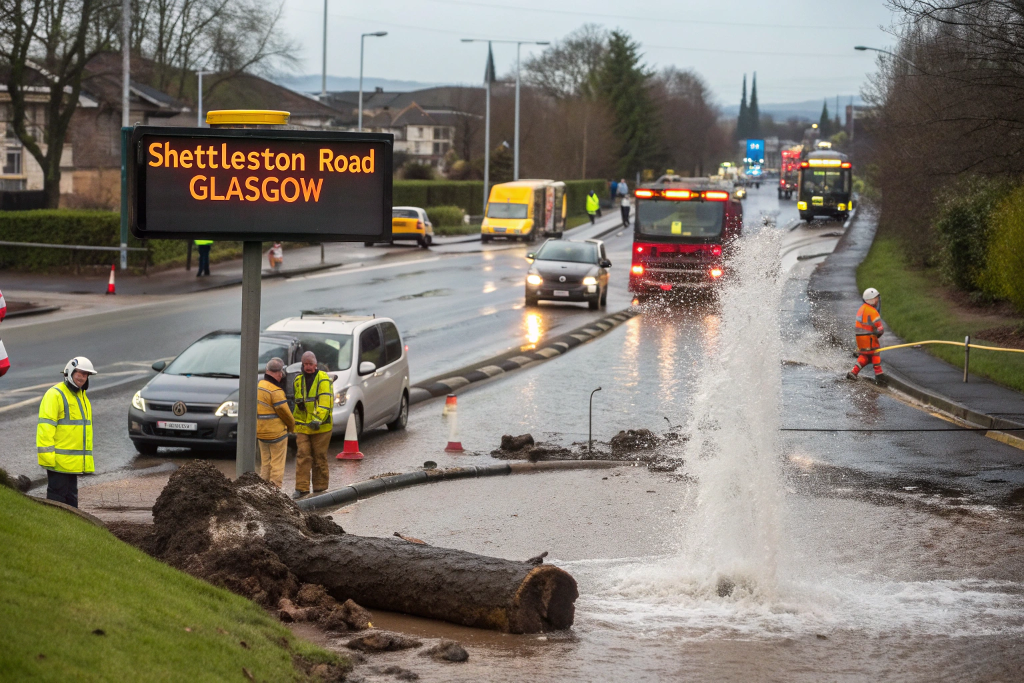The Glasgow water main break Shettleston Road caused widespread disruption in the city’s East End. Homes, businesses, and commuters faced immediate problems. Residents reported low water pressure, discolored water, and temporary outages. Shops, schools, and cafés had to close, impacting daily life. Traffic slowed as road sections flooded, forcing detours.
Scottish Water responded quickly, dispatching repair crews to isolate and fix the damaged section. The incident exposed weaknesses in aging infrastructure and raised questions about long-term resilience. Understanding the cause, impact, and repair process is crucial for residents and city planners alike.
What Is the Glasgow Water Main Break Shettleston Road?
The Glasgow water main break Shettleston Road refers to a rupture in a major underground pipeline beneath Shettleston Road. This main supplies water to thousands of households and businesses in the G31 and G32 postcodes. When the pipe broke, water flooded streets, causing low pressure and temporary supply loss.
The affected area includes Shettleston, Parkhead, and Tollcross. Emergency crews had to close parts of the road to safely access and repair the main. Residents experienced a sudden disruption, showing how dependent the city is on this critical infrastructure.
Immediate Impact on Residents and Businesses
The water main break affected daily life for residents and businesses alike. Many homes had low water pressure or discolored water due to air and sediment entering the system. Restaurants, cafés, and salons had to close, and schools struggled with hygiene needs.
Traffic congestion increased as repair crews worked, creating long delays on main roads. Residents were asked to conserve water and follow updates from Scottish Water. Despite the disruption, quick action by emergency teams minimized potential hazards.
Traffic and Road Disruptions
The burst also disrupted traffic along Shettleston Road, a key transport route. Authorities closed sections of the road to allow repair work. Detours forced drivers through residential streets, causing further congestion. Bus routes were temporarily suspended in some areas.
Emergency crews coordinated with traffic authorities to manage the situation. While travel was difficult, the closures ensured both worker and public safety.
Why the Glasgow Water Main Break Shettleston Road Happened
The Glasgow water main break Shettleston Road happened mainly because of aging pipes. Many underground mains were installed decades ago using cast-iron materials. These pipes deteriorate over time and become prone to cracking.
Temperature changes worsened the situation. Cold weather contracts metal pipes, and warmer days expand them. Over time, this stress weakens joints. Heavy rainfall and shifting soil around the pipe increased pressure on the main. Traffic and vibrations from vehicles also likely contributed to the rupture. Together, these factors caused the sudden burst.
Scottish Water’s Emergency Response
Scottish Water acted quickly to contain the break. Crews isolated the damaged section, drained excess water, and began repairs. Temporary water supplies helped essential services during restoration.
Engineers replaced the broken pipe section and tested the system to ensure proper pressure and water quality. Communication with residents was maintained through updates, reducing confusion and anxiety.
Repair and Restoration Timeline
Repairing the Glasgow water main break Shettleston Road requires multiple steps. The main section must be replaced, tested, and flushed. Roads need resurfacing and stabilization before reopening.
Partial water supply was restored within 12–24 hours, but full restoration may take several days. Residents may notice minor discoloration or air in the taps, which is normal after large repairs.
Environmental and Structural Factors
Environmental factors worsened the main break. Shifting soil, heavy rainfall, and temperature changes all stressed the pipe. Roads in busy areas experience constant vibration from vehicles, further weakening older mains.
The incident highlights the need for regular inspection and modernization. Glasgow’s aging water infrastructure requires constant monitoring to prevent similar events in the future.
Community Response
The local community responded quickly to help those affected. Residents shared bottled water and checked on vulnerable neighbors. Scottish Water provided timely updates, helping people plan around disruptions.
Schools, healthcare facilities, and businesses prioritized critical needs. Community resilience and cooperation minimized the overall impact of the incident.
Preventing Future Water Main Breaks
Preventing future bursts requires proactive investment. Scottish Water plans to replace old mains and install modern, durable pipes. Smart monitoring systems can detect small leaks early, reducing the risk of major failures.
Regular maintenance and infrastructure upgrades will strengthen the system. The Shettleston Road incident highlights the importance of forward-looking planning for urban water networks.
FAQs –
1. What caused the Glasgow water main break on Shettleston Road?
Aging pipes, fluctuating water pressure, soil movement, and temperature changes caused the break.
2. Which areas were affected?
G31 and G32 postcodes, including Shettleston, Parkhead, and Tollcross, experienced low water pressure and temporary outages.
3. How long will repairs take?
Partial restoration occurs within 12–24 hours. Full repair, including pipe replacement and road resurfacing, may take several days.
4. What should residents do during the outage?
Residents should conserve water, follow updates from Scottish Water, and run taps briefly after restoration to clear air or sediment.
5. How is Scottish Water responding?
Crews isolated and repaired the broken section, restored temporary supply, and communicated updates to the public.
6. Will the incident cause long-term disruptions?
Full water restoration is expected, but inspections of nearby pipes will continue to prevent future issues.
7. How can future breaks be prevented?
Modernizing pipes, using durable materials, installing smart monitoring systems, and conducting regular maintenance can prevent future bursts.
Conclusion
The Glasgow water main break Shettleston Road highlighted the vulnerabilities of aging urban infrastructure. Quick response from Scottish Water restored essential services efficiently. Residents experienced temporary disruptions, but effective communication and repair efforts minimized overall impact.
The incident emphasizes the need for modernization, continuous maintenance, and investment in smart monitoring. Glasgow must strengthen its water network to ensure reliability for residents and businesses. The Shettleston Road break serves as a reminder of the critical role infrastructure plays in daily life and the importance of proactive urban planning.



